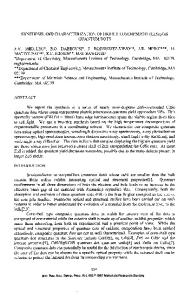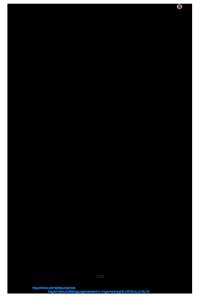Fabrication, Characterization, and Nanotoxicity of Water stable Quantum Dots
- PDF / 567,510 Bytes
- 9 Pages / 432 x 648 pts Page_size
- 78 Downloads / 380 Views
MRS Advances © 2020 Materials Research Society DOI: 10.1557/adv.2020.260
Fabrication, Characterization, and Nanotoxicity of Water stable Quantum Dots Eduardo A. Chaparro Barriera1 and Sonia J. Bailón-Ruiz2 1
Department of Biology University of Puerto Rico at Ponce
2
Department of Chemistry and Physics, University of Puerto Rico at Ponce
ABSTRACT
Quantum Dots (QDs) like Cadmium Sulphide have exciting applications, consequent to their size-dependent optical properties. This compound is used as a pigment in papers, paint, and it can also be found in solar cells. Due to the high use of nanoparticles in society, there is a significant concern in the scientific community about the potential toxicity of these nanomaterials in aquatic environments. According to this main problem, we have a theoretical assumption that Cadmium Sulphide (CdS) particles at nanoscale are more toxic than those in macroscale (bulk), and a higher concentration means higher toxicity. To verify its toxicity in the aquatic environment, first, we need to make sure the nanoparticles are soluble in water. Based in the mentioned before, the objectives of this research were: (i) synthesize Cadmium Sulphide QDs in aqueous phase in presence of biocompatible molecules like L-Glutathione and N-Acetyl-L-cysteine, (ii) characterize the quantum dots optically, structurally and morphologically and; (iii) evaluate the toxicity of Cadmium Sulphide in biological systems. CdS, L-Glutathione-covered CdS and N-AcetylL-Cysteine-covered CdS evidenced shoulder peaks at 473 nm (2.40 eV), 450 nm (2.62 eV) and, 381 (3.03 eV) nm, respectively. A broad and high emission peak centered at 545 nm was observed for CdS Nps covered with N-acetyl-L cysteine; whereas as QDs without cover and those covered with L-glutathione showed weak peaks in the visible range (470 nm-650 nm). The presence of L-Glutathione or N-Acetyl-L-cysteine on the quantum dots surface was verified by Infrared Spectroscopy. Energy Dispersive X-Ray Spectroscopy (EDX) assays evidenced the chemical composition of produced nanostructures having 57.91% of S and 42.09% of Cd. The morphology and the size were carried out by High1
Downloaded from https://www.cambridge.org/core. Macquarie University, on 30 May 2020 at 16:22:55, subject to the Cambridge Core terms of use, available at https://www.cambridge.org/core/terms. https://doi.org/10.1557/adv.2020.260
Resolution Transmission Electron Microscopy (HR-TEM). In this way, nanoparticles were spherical and with a size of ~3 nm. Toxicity results evidence that nanoparticles covered with N-Acetyl-L-Cysteine had a negative interaction in marine organisms at concentrations higher than 700 ppm, after 24 or 48 hours of contact. Also, CdS bulk showed absence of toxicity to marine crustaceans.
INTRODUCTION: The applications of the luminescent quantum dots have been incrementing during the last years due to their size-dependent optical properties. The quantum dots are nanostructures below the 10nm that have many unique optical properties depending on how they have been sy
Data Loading...










